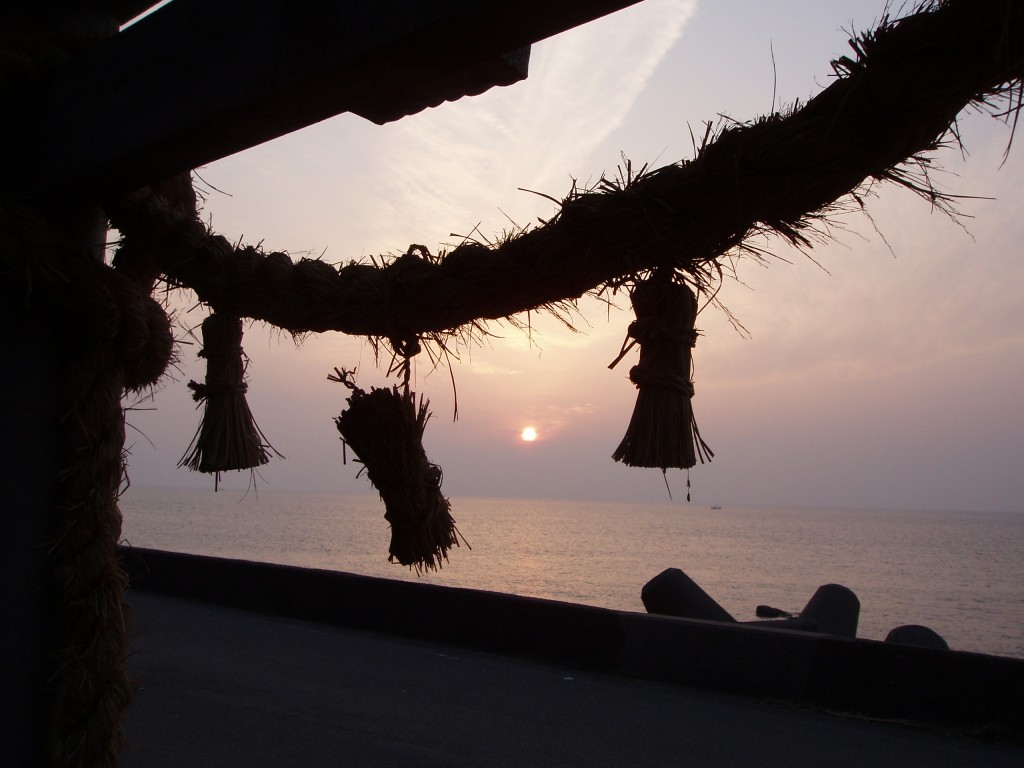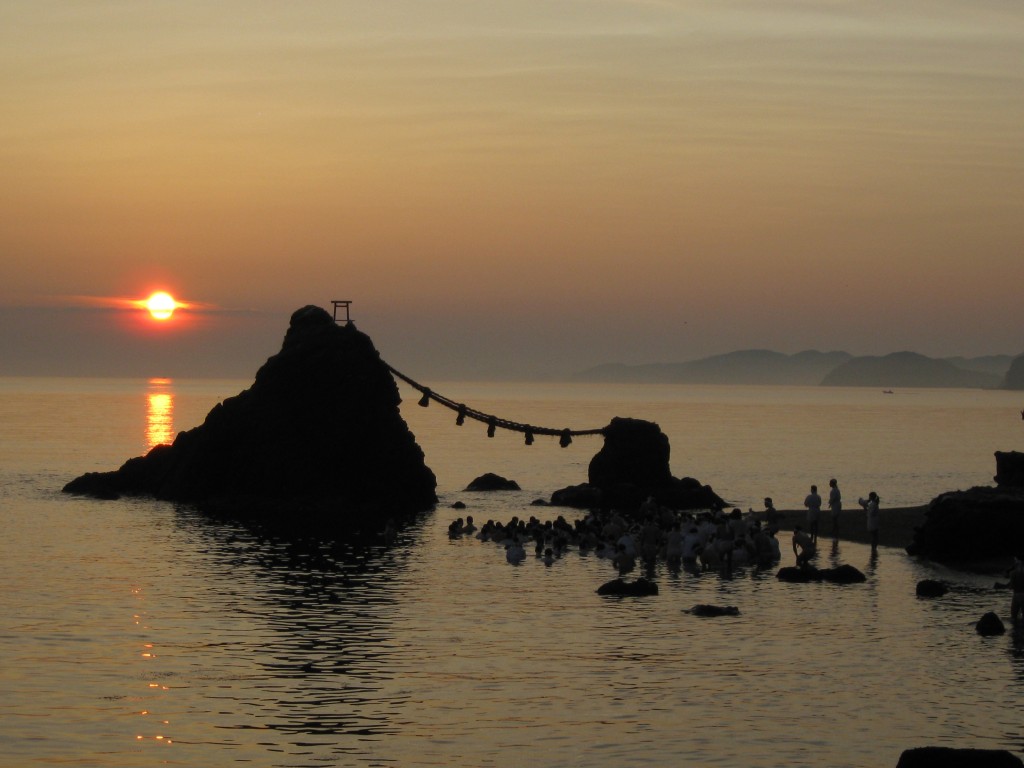
I’ve long been an admirer of the writings of Michael Hoffman, “special to the Japan Times”. He has an enviable ability to condense and clarify arcane matters in lucid terms. In an article from 2009 I’ve just come across he gives a lengthy but insightful overview of Japan’s Rising Sun emblem. It’s packed with useful information, and for those without the time or inclination to read through it all there’s a summary of key points and quotations below. (For the full article, click here.)
* The present emperor underwent a ceremony affirming his connection with the sun goddess, Amaterasu. He’s claimed to be the 125th descendant in direct line from her.
* The Rock Cave myth, central to Shinto, is funny and playful in a way characteristic of Japanese culture
* Worship of a sun goddess was probably initiated by Ise fishermen, according to an article in The Cambridge History of Japan.

Opening the door of Amaterasu's cave
* The imperial clan orignally worshipped Takamimusubi. Contact with Korea motivated them to turn to the sun sometime in or after the fourth century. They looked to Ise, already a focus of sun worship and located in the direction of the rising sun. It led to the championing of a putative ancestor called Amaterasu (literally, Heavenly Shining One).
* Prince Shotoku (572-622) was the first Yamato leader to title himself “sovereign of the land of the rising sun”. The country’s name subsequently changed from Wa, or Daiwa, to Nihon, also read as Nippon (literally, sun source).
* First use of the rising sun flag was supposedly by the nationalist Buddhist priest Nichiren, who presented the shogun with a banner of a red sun against a white background at the time of the attempted Mongol invasion in 1274.
* The banner was subsequently used by various feudal lords and later by Hideyoshi when invading Korea.
* Nativist scholars of the eighteenth century rediscovered and championed Amaterasu. “The august imperial country (Japan) is the august country in which the awesome august divine ancestor Amaterasu Omikami came into being. The reason this country is superior to all other countries is, first and foremost, apparent from this fact,” wrote Motoori Norinaga.
* “Atsutane,” sums up the historian Goodman, “pointed to the remarkable coincidence of the centrality of the sun in the Copernican system and the central role of the Sun Goddess, Amaterasu Omikami, in the Shinto tradition, going so far as to suggest that heliocentricity may in fact have originated in Japan.”
* In 1870 the Meiji government made the Hinomaru the official flag of Japan as part of its ideology of putting the emperor at the centre of the nation’s affairs. It remains so to this day, and Amaterasu is still unofficially the emperor’s ancestor and Shinto’s supreme deity worshipped at Ise Jingu.

Sunrise and shimenawa: what could be more Japanese?


That’s a speedy summary, with some erroneous half-truth here. I don’t know this Hoffman person, but there is a lot of debate around “Nihonjinron”, and what he and you says are hypothesis.
* What we know is the Emperor and Yamato ôcho is not the descendant of Amaterasu, but of every major Kami. They especially mention Amaterasu because it’s from her their heavenly mandate came from. And they still praise Takamimusubi.
* The theory saying Yayoi civilization was brought upon japanese islands by outsiders implies the Yamato ôcho was already praising Amaterasu Sume Okami when they conquered the land. Because it’s eliminate the “because of contacts with Korea” theory. If they passed thru it, they already knew Oyashima islands were the most eastern known land and saw from Korea the sun raised from Japan.
* The theory saying they simply “created” Amaterasu is nothing short of ridiculous. In ancient Greece, cities had their own tutelary god. It was the same with ancient Japan, tribes and countries had their own tutelary god. Amaterasu was Yamato ôcho’s one. When they won the war over Izumo, they just added it into Mythology, by making Susano’o submit to Amaterasu. And why not after all ? That’s what myths and legends are.
* Shôtoku Taishi didn’t used the title for himself. He gave a new interpretation of the greatly honorific and exalted title of “Sumera Mikoto” and tried to translate it into kanji. Besides, some theory postulate Shôtoku Taishi is Jesus or some myths around him was inspired by him.
* The national flag does not come from Nichiren in the first place, but from Korozen-no-goho.
* As a staunched monarchist, Motoori Norinaga was shocked of chinese, koreans and western barbarians murdering their monarchs. In Japan, the same dynasty remained on the throne since forever. That is why he claimed Japan was better suited than Qing manzhu for the name of “Chûgoku” (central realm, middle earth… hum… ? lol) used by chinese for China as a whole. Don’t forget China was the brightest civilisation and strongest country around at that time (and they still may be… if you consider modern china as China, of course).
And I should add this I forgot last time :
His Imperial Majesty The Heavenly Emperor of the Great Land of the Rising Sun… is still officially the descendant of Ama-terasu Sume O Kami.
The infamous “Ningen Sengen” merely proclaimed the Emperor was not “Gawd made manifest” (as opposed as an Hitorigami, who is hidden from human sight) and that Shôwa-Tennô himself (at least) identified as a “Ningen” which DOES NOT mean “human being” but refer to a kind of existence in Buddhist reincarnation system, especially link with humans, mortality, family, friendship and petty concerns. A divine or supernatural being may just as well be a Ningen, or sometimes being a Ningen and sometimes not be one. And even if we consider the “I am not an Akitsumikami” passage as true for all the Emperors of Japan, then it simply means he is not a 現御神, but it doesn’t mean he is not 現神 or 現為明神 or 明神 or 明御神 (Yes… all of them reads Akitsumikami). It’s not sophistry. Rather, it is clever scheme to counter another atheist Socialist attempt to destroy a Monarchy and kill dozens of millions of people and utterly disfigure a Civilised country forever.
In normal circumstances, the Emperor is supposed to live an almost etheral life, as pure and bright as a sacred Mirror. And tirelessly pray to unleash blessings upon His subjects (something most elected politicians won’t ever do for a day) with the help of his special link to the Divine.
But.
During WWII, it was impossible because the Nation was in great turmoil and danger. Because the people was suffering, the Emperor felt strongly their sufferings and felt “Ningen” classified emotions. This is “mystic” way or saying, for exemple, “the CEO of the company lowered his own salary because the company was in a bad financial situation, and this is normal.” In “Nihon O Dai Ichiran” it is written the Emperor traditionnaly assume every calamity who befall His people, meaning if their is an earthquake, it’s the Emperor’s role to fix the problem, either by praying the Gods and easing their wrath, or taking any other appropriated mesure.
The fact most people don’t understand this and continue to simply repeat lies is quite tiring, from a Monarchist point of view… and surely, for Nationalists Shintoists believers too. -_-“